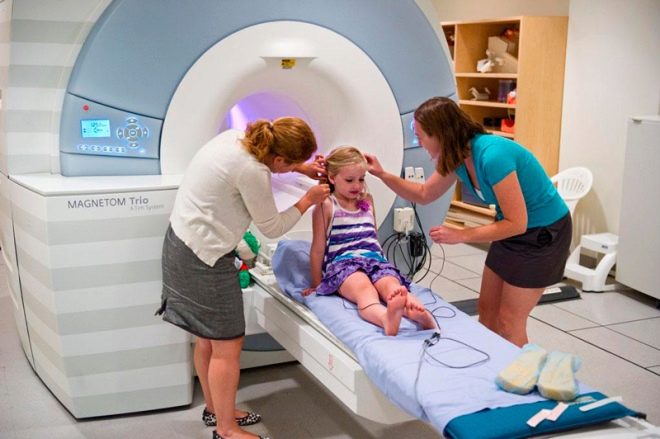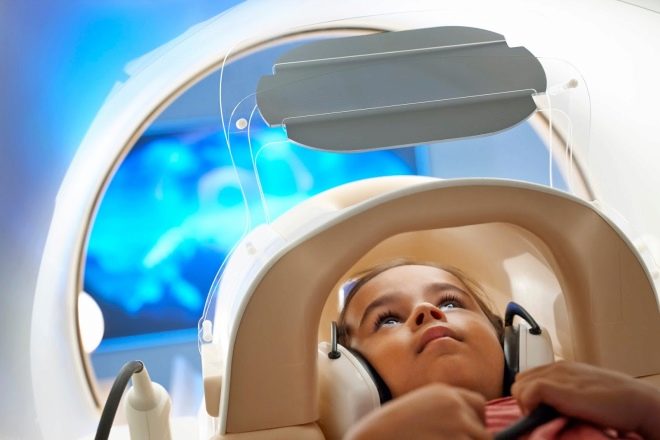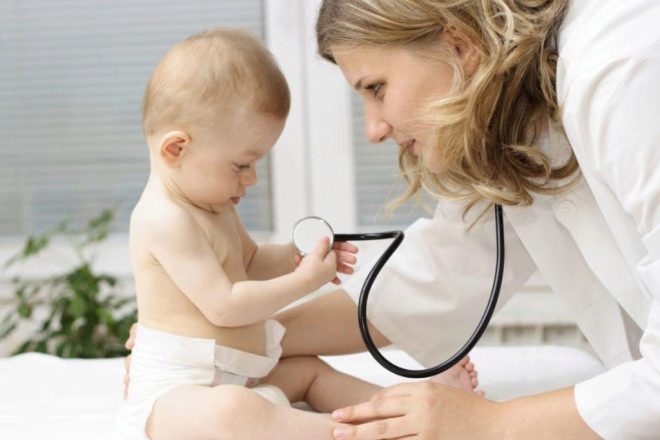CT scan (computed tomography) of the brain of a child
Computed tomography (CT) scan of a child’s brain may be required at any time. Not only suspicions of diseases of the brain and nervous system, but also head injuries of various origins can force doctors to issue such a referral. In this article, we will describe how CT is performed and what shows, as well as how to properly prepare a child of any age for the examination.
What it is?
With the advent of computed tomographic studies, physicians were able to study any internal organs of a person without injuring him, without violating their integrity. CT provides an opportunity to study a specific organ in layers and in detail. The essence of the method is based on the fact that tissues of different density reflect x-rays in different ways. This allows you to get a very detailed picture of the organ and all its inner layers and to detect even minimal deviations in its state. For the development of the method in 1972, scientists received the Nobel Prize.
From the MRI technique differs by the type of rays. An MRI scan is performed due to electromagnetic radiation, and X-rays are used for CT. It would seem that electromagnetic radiation is less harmful, why not examine children for an MRI? The answer is simple: MRI does not always give accurate results and can detect the problem. The accuracy of CT is higher.
Even in spite of the fact that radiation doses are used for diagnostics in children, the minimum examination is done strictly according to the indications and only when the harm from the diagnosis itself does not exceed the harm from its absence. Certain damage from X-rays exists, but severe pathologies of the brain, if suspected of which CT is assigned, can harm the child much more than a single dose with minimal doses.
How old is it?
Prescribe a test can a child of any age - a newborn, nursing, child who is already 3 years old and older. Infants are more likely to have neurosonography (ultrasound of the brain). And only if preliminary studies show abnormalities, it may be necessary to confirm or refute the presumptive diagnosis using CT.
A feature of computed tomography of the brain in early childhood is that before it use the means to immerse the child in a deep medication sleep (anesthesia). During the examination, the patient should lie quite motionless for quite a long time, and there is no practical possibility for the child to do this.
Indications for use
As already mentioned, computed tomography can be appointed only in extreme cases. Without much need, try not to use this method. Such valid reasons are:
- severe birth injuries to the head (depressed skull fracture, displacement of bones, wound or extensive hematomas of the brain with hemorrhage, etc.) - the study is carried out in the very first hours after the child is born;
- received injuries as a result of falling on the head (in case of suspected brain pinching, injury to certain parts of it, fractures of the skull bones) - the study is carried out as soon as possible after hospitalization on the occasion of the injury;
- prolonged intracranial hypertension unexplained origin (allows to establish the causes) - is carried out after the condition is diagnosed by other methods several times in a row;
- mental disorders and diseases (to confirm the diagnosis and search for the cause) - carried out in the direction of a psychiatrist to children over 3 years old
- tumors, cysts, neoplasms any genesis in the brain - conduct a study after confirming the presence of a tumor by other methods to establish the nature and extent of the formation;
- vascular disorders, acute and severe violation of cerebral circulation;
- paralysis, paresis, impaired motor functions (both congenital and sudden onset).
Contraindications
Computed tomography of the head of the child will not be carried out if he is allergic to substances used as contrast, for example, to iodine. Do not do the examination and children with severe renal insufficiency.
In the presence of metal objects in the body, which can be implants, staples, CT is also not carried out. They can refuse to diagnose even if the child has a severe mental disorder, accompanied by an inadequate response to drugs for anesthesia. Contraindications include severe forms of diabetes mellitus, multiple myeloma, and some thyroid disorders.
How is it going?
To conduct such diagnostics in medical institutions, special rooms equipped with a modern tomograph are equipped. This is a very complex device, thought out to the smallest detail, equipped with sensors with an incredibly high sensitivity to X-ray reflection. Data from the detectors come to the computer, where the image is formed. Very complex and extensive computer programs help the doctor correctly and correctly decipher the data.
The child is weighed so that the anesthesiologist can accurately calculate the amount of the drug to be injected for immersion into a deep sleep medication. Then a contrast agent based on iodine is injected into the baby’s vein. When examining the brain diagnosis with contrast is considered the only accurate.
If you get the results of CT of bone tissue, for example, the spine, it is possible without a contrast agent, then a brain study without contrast will be uninformative. Older children do not give anesthesia.
The child is placed on the table of the scanner in the supine position. The head is fixed in the desired position with the help of soft straps. The table slides inside the tomograph capsule. Mom and other people are asked to leave the office during the operation of the hardware complex.
Scanning lasts from 30 minutes to an hour and a half, the results will be ready about an hour after the end of the survey, in emergency cases - after 20-30 minutes.
Do I need training?
Preparation is required without fail. 3-4 hours before the examination, the child is not given food and water if immersed in a drug sleep. A child who, because of his age, does not need anesthesia, can be fed approximately a couple of hours before the CT scan.
A child who is going to have a procedure without anesthesia must definitely be told that nothing terrible and painful will happen. Chad can be invited to play in a spacecraft, because the scanner really resembles the scenery from Star Wars. Be sure to warn that the main rule - the lack of movement and movement during the survey.
In order for the child’s breathing to be complete during the study, it is necessary to instill in him the vasoconstrictor drops in the nose. Provide all the required tests before the diagnosis: a pediatrician's conclusion, ECG results, complete blood count and the same urine test.
If the child is allergic or very small, so that the doctors have enough information about the allergic status, it is recommended to visit an allergist or pediatrician in advance and make samples for contrast agents based on iodine. Help on the absence of a negative reaction to iodine is also provided before starting the study.
If CT is performed on an emergency basis, for example, due to injury, preliminary preparation is omitted, limited to only a short rapid test for allergy to a contrast agent.
Reviews
According to reviews of moms, the procedure scares not only children, but also parents. Moms are afraid for the consequences of X-ray exposure, as well as for the child being in the tomograph capsule, if he is not allowed to have anesthesia. It happens that a 10-12 year old child makes a real scandal, refusing to go to the capsule.
In many children's hospitals in Russia today open scanners are installed for children, in which the child should not be in a confined space. This tomograph shows all the necessary no worse, but psychologically, children perceive it better and easier.
Children, according to moms, rarely tolerate anesthesia easily. Awakening is often unpleasant.
You will learn more about how a brain CT scan is performed on a child in the following video.




















